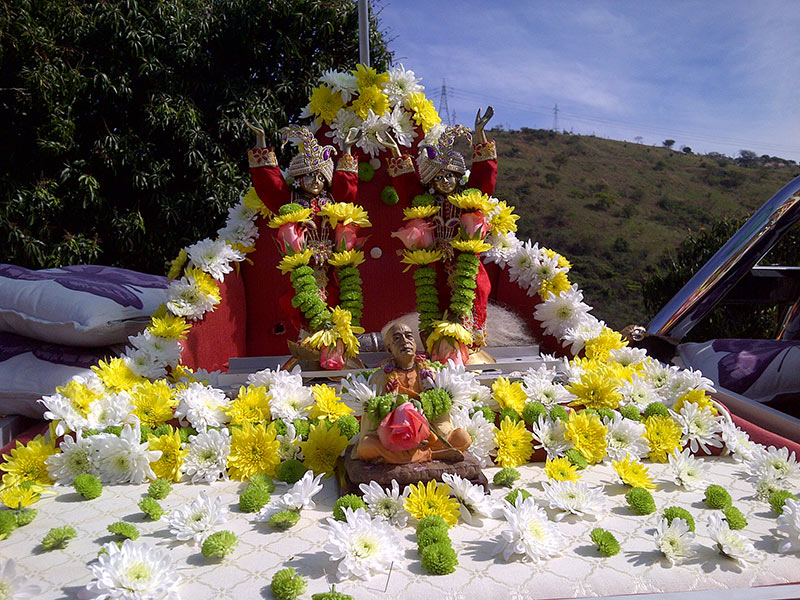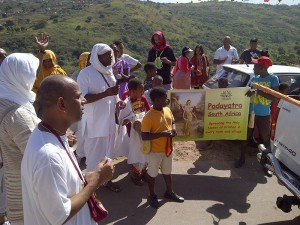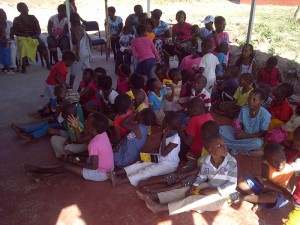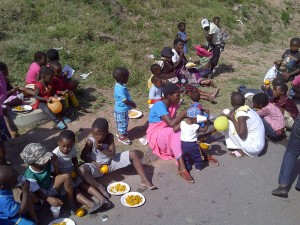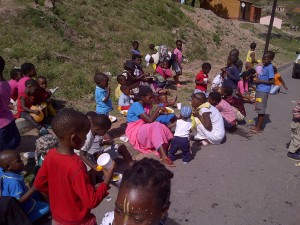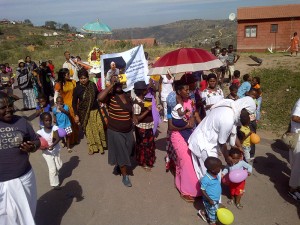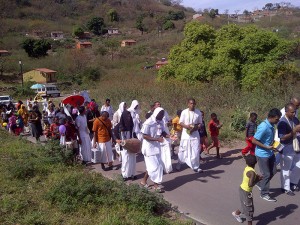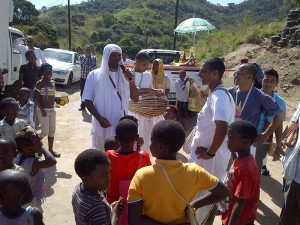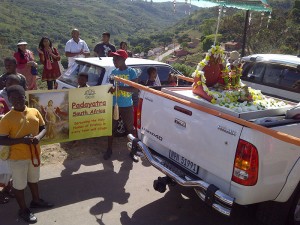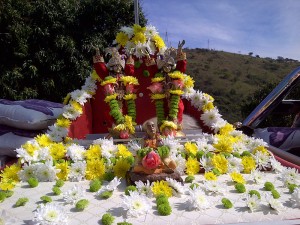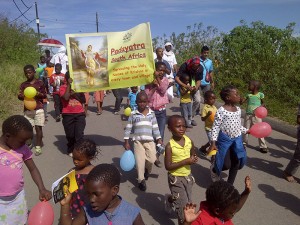Given the repressive laws in South Africa prior to 1994, the idea of padayatra was at best not possible. Post democracy meant that there was greater freedom to exercise religious and cultural activities. That’s why, on September 3, 1994, one hundred chanting and dancing devotees wheeled the country’s first padayatra cart along the main street of Durban to the city hall, with the mayor of Durban, Mike Lipchitz, cutting the inaugural ribbon. In 1996 padayatra went with the same Deity cart and a Prabhupada murti to each of the thirty nama-hatta centers in greater Durban. It happened mostly on weekends, usually ending with a hall program.
The idea of doing padayatra again in South Africa emerged during one Lokanath Swami’s visit to the country. A small group of enthused disciples, headed by Sadhana Shakti Devi Dasi and her husband Bhakta Vinod , took their guru’s request as his instruction and launched Padayatra South Africa onNovember 10, 2012. This was the auspicious day of Trayodasi Ekadasi during the month of Kartik. With the excellentsupport of the Sri Sri Radhanath Temple and congregational devotees, about 140 devotees, including men, women and children, joined the ten kilometre long padayatra. The venue for the launch of the South African padayatra was significant: the Sri Laksmi Narayan temple hall in Mobeni Hall was selected. Srila Prabhupada only visited South Africa once on 8 October 1973, and it was in this hall that in his address to the congregation he indicated his desire for an ISKCON Temple be built in Chatsworth, a sprawling township about fourteen kilometers away from the largest city of Durban in the Kwazulu Natal province. Amid great struggles, but driven by Srila Prabhupada’s instructions, the devotees completed the Sri Sri Radha Radhanath Temple of Understanding in 1985. It is acclaimed to be one of the most beautiful architectural masterpieces on the African continent.
For the 2012 padayatra devotees built a lightweight aluminium palanquin and carefully decorated it. Flower garlands of brilliant yellow and red were beautifully roped around the pillars of the palanquin where they gently placed the life size murti of Srila Prabhupada, weighing about fifteen and a half kilograms. After offering arati, the group commenced their walk to the Sri Sri Radha Radhanath Temple of Understanding about ten kilometres away. Within kilometres the walking party entered the township of Chatsworth, a historically Indian township located south-west of the Durban city centre, with a population of 750000 people. One is immediately struck by a deep sense of community that exists in this township as they offered water and fruits to the padayatra party. Women and children rushed out of their homes waving enthusiastically, trying to get a glimpse of Srila Prabhupada whom they assumed to be a real person being carried on the palanquin. En route, the support offered by the business community which included the tiny corner plaza shops and the large manufacturing industry was overwhelming. The padayatra party envisaged scorn and hostility, but the group was pleasantly surprised by the reception offered to them by the Christian and Muslim communities. The fact that Muslim businessmen were appreciative of the padayatra party can be attributed to the fact that the idea of pulling a chariot is not entirely new to the Muslim community. In South Africa, in the early 1990’s a major Muslim festival called Mohurram was celebrated by the Indian community. Bamboo and other materials were collected to build a tajjia which was between 15-25 feet high, constructed in wood and covered in coloured paper. On the tenth day of the Mohurram, people, especially the Hindus and Muslims, gathered around each tajjia singing and pulling the miniature mausoleums across the streets, eventually releasing these into the river. This festival is only practiced by a small minority of Muslims in Durban.
Further, the Kavady festival also takes to the streets during the month of May each year in Chatsworth. This is when the Hindus worship Lord Muruga, in the hope of getting rid of illnesses and misfortune. Hundreds of Hindus carrying decorated wooden bands across their shoulders walk through the streets of Chatsworth. The braver devotees indulge in tongue piercing. Large lime fruits are also threaded into the shoulders and backs of a few worshippers. The offering of fruit, water and money is traditional during these events and the contributions that we received were in the spirit of piety already known to the many that we passed on our way back to the temple.
Alongtheroad devotees distributed Ekadasi prasadam, which included packets of roasted peanuts, sugar candy, raisons and coconut flakes to the curious onlookers. The vibrant kirtana lured the shy and the intrepid onlookers to rhythmically move to the music. Children ran alongside the palanquin hoping to get a response from Srila Prabhupada! A support crew distributed fruit and water to devotees during the long and hot walk. As Srila Prabupada looked on from his palanquin,the devotees enthusiastically distributed his books. About 500 books were distributed on that South African padayatra. Evenelderly matajis walked the entire distance.
For the subsequent padayatras, which were held in the townships of Phoenix and Welbedacht in the same province, the temple authorities did not let the large Srila Prabhupada murti be taken out, given the potential damage on the road. TheDeitiesof Sri Sri GauraNitai, along with the small Prabhupada murti of Sadhana Shakti Dasi, thus replaced Srila Prabhupada large murti on thepalanquin. The total distance was reduced to about four kilometres because it was more practical and this enabled a more intense preaching program with the target communities, including the distribution of japa beads.
Bhakta Vinod: Padayatra South Africa still has the support of the same devotees from our Templeof Understanding andits congregation. On either side of the road , we have devotees engaged with the public – distributing nicely packed “simply wonderful” sweets , invitations to our Temple and of course Srila Prabhupada`s books. Each time we go out, we have more devotees joining us – and the response from the public gets more and more rewarding.
In South Africa it is compulsory to get permission from the local municipalities to use the roads, and the use of the traffic police is mandatory. During the week-ends we held padayatras the structure of the roads presented problems to the cart because of the traffic congestion. The padayatra team had to manage irate drivers but the cordial approach of the devotees resolved such issues.
Every three months, Their Lordships are now taken out on padayatra. At present the organizers have targeted essentially the poor and disadvantaged communities because much relief is needed there, both physical and spiritual. So far they have covered several areas in the Province of Kwazulu Natal,and the plan is to expand Padayatra South Africa nationally. In the midst of their endeavours, Padayatra organizers are invoking the mercy of Sri Sri Gaura Nitai, Srila Prabhupada and Lokanath Swami to ensure an ever expanding Padayatra South Africa.

